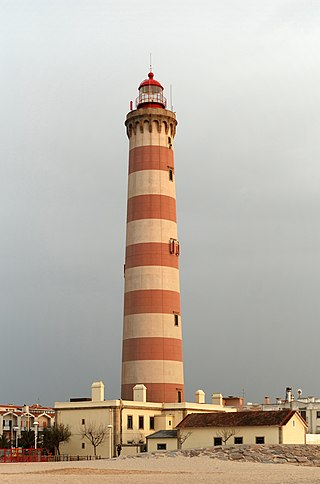
A lighthouse is a tower, building, or other type of physical structure designed to emit light from a system of lamps and lenses and to serve as a beacon for navigational aid, for maritime pilots at sea or on inland waterways.

Stage lighting is the craft of lighting as it applies to the production of theater, dance, opera, and other performance arts. Several different types of stage lighting instruments are used in this discipline. In addition to basic lighting, modern stage lighting can also include special effects, such as lasers and fog machines. People who work on stage lighting are commonly referred to as lighting technicians or lighting designers.
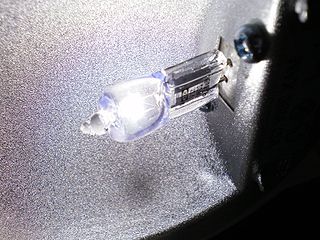
A halogen lamp is an incandescent lamp consisting of a tungsten filament sealed in a compact transparent envelope that is filled with a mixture of an inert gas and a small amount of a halogen, such as iodine or bromine. The combination of the halogen gas and the tungsten filament produces a halogen-cycle chemical reaction, which redeposits evaporated tungsten on the filament, increasing its life and maintaining the clarity of the envelope. This allows the filament to operate at a higher temperature than a standard incandescent lamp of similar power and operating life; this also produces light with higher luminous efficacy and color temperature. The small size of halogen lamps permits their use in compact optical systems for projectors and illumination. The small glass envelope may be enclosed in a much larger outer glass bulb, which has a lower temperature, protects the inner bulb from contamination, and makes the bulb mechanically more similar to a conventional lamp.

A Fresnel lens is a type of composite compact lens which reduces the amount of material required compared to a conventional lens by dividing the lens into a set of concentric annular sections.
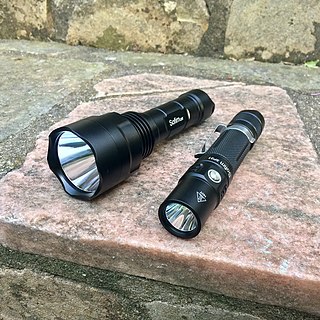
A flashlight (US), or torch (CE) is a portable hand-held electric lamp. Formerly, the light source typically was a miniature incandescent light bulb, but these have been displaced by light-emitting diodes (LEDs) since the early 2000s. A typical flashlight consists of the light source mounted in a reflector, a transparent cover to protect the light source and reflector, a battery, and a switch, all enclosed in a case.

A headlamp is a lamp attached to the front of a vehicle to illuminate the road ahead. Headlamps are also often called headlights, but in the most precise usage, headlamp is the term for the device itself and headlight is the term for the beam of light produced and distributed by the device.
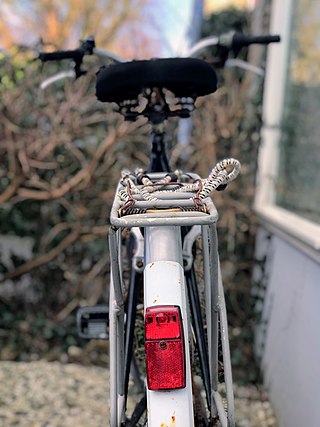
Bicycle lighting is illumination attached to bicycles whose purpose above all is, along with reflectors, to improve the visibility of the bicycle and its rider to other road users under circumstances of poor ambient illumination. A secondary purpose is to illuminate reflective materials such as cat's eyes and traffic signs. A third purpose may be to illuminate the roadway so that the rider can see the way ahead. Serving the latter purposes require much more luminous flux and thus more power.

Ellipsoidal reflector spot is the name for a type of stage lighting instrument, named for the ellipsoidal reflector used to collect and direct the light through a barrel that contains a lens or lens train. The optics of an ERS instrument are roughly similar to those of a 35 mm slide projector.

In stage lighting, an ellipsoidal reflector floodlight, better known as a scoop, is a large, simple lighting fixture with a dome-like reflector, large high-wattage lamp and no lens. It consists almost entirely of a lamp in the center of a big curved metal dome that acts as a reflector. The result is a wide, soft-edged pool of light good for general lighting. However, since scoop lights do not have a mechanism for cutting down the size of their beam, they are rarely used for more specific lighting needs.

A parabolic aluminized reflector lamp is a type of electric lamp that is widely used in commercial, residential, and transportation illumination. It produces a highly directional beam. Usage includes theatrical lighting, locomotive headlamps, aircraft landing lights, and residential and commercial recessed lights.

Intelligent lighting refers to lighting that has automated or mechanical abilities beyond those of traditional, stationary illumination. Although the most advanced intelligent lights can produce extraordinarily complex effects, the intelligence lies with the human lighting designer, control system programmer(For example, Chamsys and Avolites), or the lighting operator, rather than the fixture itself. For this reason, intelligent lighting (ILS) is also known as automated lighting, moving lights, moving heads, or simply movers.

A Fresnel lantern is a common lantern used in theatre that employs a Fresnel lens to wash light over an area of the stage. The lens produces a wider, soft-edged beam than a spotlight or key light, and is commonly used for back light and top light.

Stage lighting instruments are used in stage lighting to illuminate theatrical productions, concerts, and other performances taking place in live performance venues. They are also used to light television studios and sound stages.

The Electronic Theatre Controls (ETC) Source Four (known by professionals and amateurs alike as Source 4, S4, Source 4 Leko, "19 / 26 / 36 / 50 Degree " is an ellipsoidal reflector spotlight used in stage lighting. First released in 1992, the Source Four was invented by David Cunningham and features an improved lamp and reflector compared to previous ERS designs, tool-free lamp adjustment, and a rotating, interchangeable shutter barrel. The Source Four is widely used by professional theaters across the globe.

A multifaceted reflector light bulb is a reflector housing format for halogen as well as some LED and fluorescent lamps. MR lamps were originally designed for use in slide projectors, but see use in residential lighting and retail lighting as well. They are suited to applications that require directional lighting such as track lighting, recessed ceiling lights, desk lamps, pendant fixtures, landscape lighting, retail display lighting, and bicycle headlights. MR lamps are designated by symbols such as MR16 where the diameter is represented by numerals indicating units of eighths of an inch. Common sizes for general lighting are MR16 and MR11, with MR20 and MR8 used in specialty applications. Many run on low voltage rather than mains voltage alternating current so require a power supply.
A beam projector is a lenseless stage lighting instrument with very little beam spread. It uses two reflectors. The primary reflector is a parabolic reflector and the secondary reflector is a spherical reflector. The parabolic reflector organizes the light into nearly parallel beams, and the spherical reflector is placed in front of the lamp to reflect light from the lamp back to the parabolic reflector, which reduces spill. The result is an intense shaft of light that cannot be easily controlled or modified. Beam projectors are often used to create a godspot effect. The beam projector no longer is used to the extent that it once was, as newer fixtures and PAR lamps have created easier ways to produce the effect. A similar effect can be produced using ETC Source Four PAR fixtures with a clear lens. A snoot/top hat can be added to control spill.

LED stage lighting instruments are stage lighting instruments that use light-emitting diodes (LEDs) as a light source. LED instruments are an alternative to traditional stage lighting instruments which use halogen lamp or high-intensity discharge lamps. Like other LED instruments, they have high light output with lower power consumption.
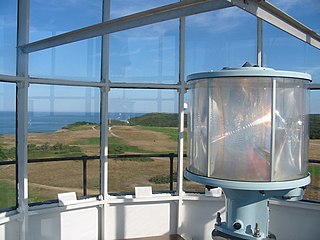
The VRB-25 is a lighthouse optical system designed and built by Vega Industries Ltd. in Porirua, New Zealand. It was originally designed in 1993–95 with the assistance of the United States Coast Guard to meet USCG requirements for a robust mechanism requiring minimum maintenance. It has become the Coast Guard's standard 12 volt rotating beacon. The company's literature says there are more than 400 installations worldwide. More than a quarter of the active lighthouses in Maine have one installed.
Stage lighting accessories are components manufactured for conventional (non-automated) stage lighting instruments. Most conventional fixtures are designed to accept a number of different accessories designed to assist in the modification of the output. These accessories are intended to either provide relatively common functionality not originally provided in a fixture, or to extend the versatility of a lighting instrument by introducing features. Other accessories have been designed to overcome limitations or difficulties some fixtures present in specific applications.

A dive light is a light source carried by an underwater diver to illuminate the underwater environment. Scuba divers generally carry self-contained lights, but surface supplied divers may carry lights powered by cable supply.



















